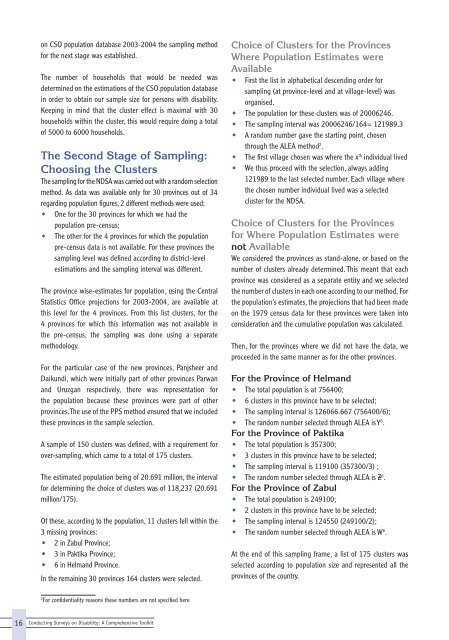Conducting Surveys on Disability: A Comprehensive Toolkit
Conducting Surveys on Disability: A Comprehensive Toolkit
Conducting Surveys on Disability: A Comprehensive Toolkit
You also want an ePaper? Increase the reach of your titles
YUMPU automatically turns print PDFs into web optimized ePapers that Google loves.
<strong>on</strong> CSO populati<strong>on</strong> database 2003-2004 the sampling method<br />
for the next stage was established.<br />
The number of households that would be needed was<br />
determined <strong>on</strong> the estimati<strong>on</strong>s of the CSO populati<strong>on</strong> database<br />
in order to obtain our sample size for pers<strong>on</strong>s with disability.<br />
Keeping in mind that the cluster effect is maximal with 30<br />
households within the cluster, this would require doing a total<br />
of 5000 to 6000 households.<br />
The Sec<strong>on</strong>d Stage of Sampling:<br />
Choosing the Clusters<br />
The sampling for the NDSA was carried out with a random selecti<strong>on</strong><br />
method. As data was available <strong>on</strong>ly for 30 provinces out of 34<br />
regarding populati<strong>on</strong> figures, 2 different methods were used:<br />
• One for the 30 provinces for which we had the<br />
populati<strong>on</strong> pre-census;<br />
• The other for the 4 provinces for which the populati<strong>on</strong><br />
pre-census data is not available. For these provinces the<br />
sampling level was defined according to district-level<br />
estimati<strong>on</strong>s and the sampling interval was different.<br />
The province wise-estimates for populati<strong>on</strong>, using the Central<br />
Statistics Office projecti<strong>on</strong>s for 2003-2004, are available at<br />
this level for the 4 provinces. From this list clusters, for the<br />
4 provinces for which this informati<strong>on</strong> was not available in<br />
the pre-census, the sampling was d<strong>on</strong>e using a separate<br />
methodology.<br />
For the particular case of the new provinces, Panjsheer and<br />
Daikundi, which were initially part of other provinces Parwan<br />
and Uruzgan respectively, there was representati<strong>on</strong> for<br />
the populati<strong>on</strong> because these provinces were part of other<br />
provinces. The use of the PPS method ensured that we included<br />
these provinces in the sample selecti<strong>on</strong>.<br />
A sample of 150 clusters was defined, with a requirement for<br />
over-sampling, which came to a total of 175 clusters.<br />
The estimated populati<strong>on</strong> being of 20.691 milli<strong>on</strong>, the interval<br />
for determining the choice of clusters was of 118,237 (20.691<br />
milli<strong>on</strong>/175).<br />
Of these, according to the populati<strong>on</strong>, 11 clusters fell within the<br />
3 missing provinces:<br />
• 2 in Zabul Province;<br />
• 3 in Paktika Province;<br />
• 6 in Helmand Province.<br />
In the remaining 30 provinces 164 clusters were selected.<br />
Choice of Clusters for the Provinces<br />
Where Populati<strong>on</strong> Estimates were<br />
Available<br />
• First the list in alphabetical descending order for<br />
sampling (at province-level and at village-level) was<br />
organised.<br />
• The populati<strong>on</strong> for these clusters was of 20006246.<br />
• The sampling interval was 20006246/164= 121989.3<br />
• A random number gave the starting point, chosen<br />
through the ALEA method 2 .<br />
• The first village chosen was where the x th individual lived<br />
• We thus proceed with the selecti<strong>on</strong>, always adding<br />
121989 to the last selected number. Each village where<br />
the chosen number individual lived was a selected<br />
cluster for the NDSA.<br />
Choice of Clusters for the Provinces<br />
for Where Populati<strong>on</strong> Estimates were<br />
not Available<br />
We c<strong>on</strong>sidered the provinces as stand-al<strong>on</strong>e, or based <strong>on</strong> the<br />
number of clusters already determined. This meant that each<br />
province was c<strong>on</strong>sidered as a separate entity and we selected<br />
the number of clusters in each <strong>on</strong>e according to our method. For<br />
the populati<strong>on</strong>’s estimates, the projecti<strong>on</strong>s that had been made<br />
<strong>on</strong> the 1979 census data for these provinces were taken into<br />
c<strong>on</strong>siderati<strong>on</strong> and the cumulative populati<strong>on</strong> was calculated.<br />
Then, for the provinces where we did not have the data, we<br />
proceeded in the same manner as for the other provinces.<br />
For the Province of Helmand<br />
• The total populati<strong>on</strong> is at 756400;<br />
• 6 clusters in this province have to be selected;<br />
• The sampling interval is 126066.667 (756400/6);<br />
• The random number selected through ALEA is Y 6 .<br />
For the Province of Paktika<br />
• The total populati<strong>on</strong> is 357300;<br />
• 3 clusters in this province have to be selected;<br />
• The sampling interval is 119100 (357300/3) ;<br />
• The random number selected through ALEA is Z 6 .<br />
For the Province of Zabul<br />
• The total populati<strong>on</strong> is 249100;<br />
• 2 clusters in this province have to be selected;<br />
• The sampling interval is 124550 (249100/2);<br />
• The random number selected through ALEA is W 6 .<br />
At the end of this sampling frame, a list of 175 clusters was<br />
selected according to populati<strong>on</strong> size and represented all the<br />
provinces of the country.<br />
2<br />
For c<strong>on</strong>fidentiality reas<strong>on</strong>s these numbers are not specified here<br />
16<br />
<str<strong>on</strong>g>C<strong>on</strong>ducting</str<strong>on</strong>g> <str<strong>on</strong>g>Surveys</str<strong>on</strong>g> <strong>on</strong> <strong>Disability</strong>: A <strong>Comprehensive</strong> <strong>Toolkit</strong>

















